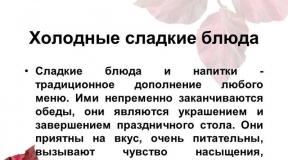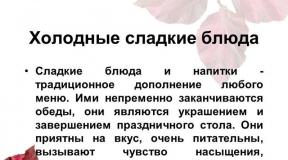Anise ordinary for coughs and in cooking. Anise tea recipe. Fennel anise cumin medicinal properties Anise and fennel are the same
In the article we discuss ordinary anise. You will learn what properties the plant has, how to properly collect, harvest and use the fruits of anise, what are the contraindications to it, and also how anise differs from cumin, star anise and fennel.
Anise ordinary or Aniseed Bedrenets is a spicy annual herb. Anise is popularly called Sweet Cumin, Breadseed or Ganus. The Latin name for anise is Anisum vulgare (Pimpinella anisum). Anise is cultivated as a flavoring and aromatic seasoning and for obtaining medicinal raw materials.
What does it look like
The appearance of anise ordinary. Anise ordinary - erect, short and thinly spread-pubescent plant up to 50-60 cm high. The upper part of the plant is branched, the stem is furrowed, rounded. The root part of the plant is thin, fusiform.
The upper leaves of anise are pinnate with linear-lanceolate lobes. In the middle part of the plant, the leaves are two- and three-lobed, reverse-wedge-shaped. In the root part, there are long-petiolized, whole lobed, incised-toothed or rounded-heart-shaped leaves.
Anise inflorescences have the shape of a complex umbrella. During the flowering period, they are covered with small nondescript flowers with white ciliate petals about 1.5 mm long.
The fruit of anise is a two-seed, heart-shaped, ovoid and inverted-pear-shaped, gray-greenish or brownish-gray in color, 3 to 5 mm long.
Where grows
In the wild, anise is very rare. Industrial cultivation of the plant is carried out in Mexico, Egypt, Asia Minor and southern Europe. In Russia, anise thigh is grown mainly in the Kursk, Belgorod, Voronezh regions and in the Krasnodar Territory.
Anise is also grown in summer cottages in central and southern Russia as a cultivated plant for food and for obtaining medicinal raw materials.
Anise fruit
The fruits of anise ordinary have a lot of useful properties for the body. For medicinal or culinary purposes, they can be purchased at the store or grown, assembled and prepared on your own.
Chemical composition
Dried anise fruits have the following chemical composition:
- essential oil (1.5-6%);
- fatty oil (16-28%);
- proteins;
- carbohydrates;
- organic acids.
By steam distillation, an essential oil is obtained from the dried fruit. Essential anise oil contains anethole aromatic ester (up to 90%), estragole (10%), anise aldehyde, anisic acid, anise alcohol and anise ketone.
Healing properties
 Anise fruits are used in folk medicine and in cooking. The most useful part of the common anise is the fruit. Anise fruit is a phytopreparation that helps to cope with cough - it has an expectorant effect.
Anise fruits are used in folk medicine and in cooking. The most useful part of the common anise is the fruit. Anise fruit is a phytopreparation that helps to cope with cough - it has an expectorant effect.
In addition, it stimulates the motor function of the intestines, and increases the secretion of gastric juice. It is also used by women to reduce the physiological effect of menopause.
In addition to fruits, essential anise oil is used, which has anti-inflammatory, antispasmodic, antiseptic and carminative effects.
In addition, it acts as a laxative, increases the secretory function of internal organs and stimulates the function of the glandular apparatus of the respiratory tract.
Anise and preparations based on it are used for the following ailments:
- intestinal colic and bloating;
- decreased appetite;
- diseases of the digestive tract;
- inflammation of the kidneys and bladder;
- urolithiasis and cholelithiasis;
- dysfunction of the liver and gallbladder;
- weak lactation in lactating women;
- lingering cough with difficult sputum;
- headaches and dizziness.
How to collect
The flowering and fruiting periods depend on the plant variety. Anise blooms from mid-June to late July, bears fruit from August to early September. Harvesting begins before the fruit is fully ripe, when about 70% of the anise umbrellas become brown.
Anise is mowed at the root and knitted in bunches, which are left to dry in a dark, well-ventilated area. The bundles are hung with umbrellas down or laid out on a blank newspaper.
After the stems of anise are completely dry, the fruits are separated from the umbrellas by threshing. The resulting fruits are cleaned of debris and scattered in a thin layer on a clean tarpaulin or paper and left to dry.
Store anise in a dark, dry place in a tightly closed container. The shelf life of raw materials is 3 years.
How to apply
In folk medicine, anise essential oil is valued, which has pronounced antitussive, antiseptic, anti-inflammatory and carminative properties.
For medicinal purposes, dried anise fruits are used for the preparation of decoctions, infusions and mixtures. In pharmaceuticals, essential oil raw materials from the fruits of anise are used in the production of various medicines.
Anise essential oil is also used in the perfumery and cosmetic industry. It is used in the manufacture of soap, various cosmetics and in the preparation of a perfume composition.
Decoctions, water and alcohol tinctures are prepared on the basis of anise fruits, tea is brewed. Anise fruits are also used as a seasoning for various dishes.
Anise cough
Anise is used as an expectorant, antitussive agent. In addition, anise has anti-inflammatory and antipyretic effects for colds. From dried fruits of anise, you can prepare a decoction that will help to cope with a lingering cough and stubborn phlegm.
Cough medicine
Ingredients:
- Dried fruits of anise - 1 tablespoon
- Natural honey - 1 tablespoon
- Water - 250 ml.
- Cognac - 1 tablespoon
How to cook: Pour a glass of hot water over the anise fruits and boil for 15 minutes. Let the broth cool and steep for about 20 minutes, then strain it through a gauze pad. Add honey and brandy to the broth. Mix all ingredients thoroughly.
How to use: Take the product warm in 1 tbsp. 3-4 times a day.
Also, on aniseed fruits, you can prepare an alcoholic cough infusion.
Alcohol infusion
Ingredients:
- Dried fruits of anise - ½ cup.
- Medical alcohol - 2.5 glasses.
How to cook: Place the anise fruits in a glass container and cover them with alcohol. Let the alcohol sit for a week. Filter the tincture with a gauze pad. Store in the refrigerator.
How to use: Before use, dilute 10-15 drops of the tincture in 50 ml of pure boiled water. Take the product 5-6 times during the day.
In cooking, anise is used in the preparation of baked goods, marinades and alcoholic beverages; it is also used as a spicy spice in meat and fish dishes.
Anise seasoning
The sweet-spicy taste of anise gives the dishes a spicy aroma. Anise goes well with various vegetables, any type of meat and fish. In cooking, fruits, inflorescences and leaves of anise are used in dried and fresh form.
Anise is a popular seasoning in Mediterranean, Asian and Slavic cuisines.
As a seasoning, anise is used in the following dishes:
- crushed anise seeds are added in the manufacture of bakery products;
- when pickling and salting vegetables, use fresh or dried anise umbrellas;
- put young greens in vegetable and fruit salads;
- anise oil is added to various sauces and dressings for salads and fish dishes;
- dried seeds are used in most spice mixtures for pilaf;
- in combination with other spices, they are used for baking and stewing red meat;
- with the help of anise, they remove unpleasant odors from meat and fish dishes;
- used in the manufacture of alcoholic beverages and cocktails;
- added to homemade compotes and jelly, as well as coffee and milk drinks.
Anise tea
Tea with anise fruits has not only a pleasant refreshing taste and aroma, but also helps in the treatment of various ailments, soothes, eliminates flatulence, relieves headaches and fever. Anise tea is also beneficial for lactating women to increase lactation.
Ingredients:
- Dried fruits of anise - 1 tsp
- Water - 200 ml
How to cook: Grind the anise fruit in a mortar or grind in a coffee grinder. Place the chopped anise in a teapot and pour boiling water over it. Let the tea brew for 10 minutes. Pour the tea through a strainer or gauze napkin into a cup. If desired, you can add a little natural honey and a slice of lemon to the tea.
How to use: For healing and sedation, consume 2-3 cups of anise tea daily. Children are advised to give no more than 100 ml of tea 1-2 times a day. As a means to increase lactation, drink 100 ml of tea half an hour before feeding.
You will find some more useful uses of anise in the following video:
Star anise and anise what is the difference
 Star anise appearance. Star anise is often called star anise due to the similarity of taste and aroma with ordinary anise, however, these are two different types of plants.
Star anise appearance. Star anise is often called star anise due to the similarity of taste and aroma with ordinary anise, however, these are two different types of plants.
Star anise, unlike anise, is a perennial shrub plant up to 10 meters high, which grows in the southeast of Asia. Badian has a complex multileaf fruit that looks like a pointed star.
Badian is used as a medicine. It has similar medicinal properties with ordinary anise - it helps with coughing, eliminates bloating and intestinal colic, has anti-inflammatory and antispasmodic effects. In addition, star anise roots are used in the treatment of malaria and fever.
However, star anise became more widespread in cooking. Unlike anise, it has a less pronounced, not sugary taste and aroma. Dried whole or chopped star anise is used in the preparation of dishes from fruits, vegetables, meat and fish, added to alcoholic and non-alcoholic drinks.
Fennel and anise what is the difference
 Fennel appearance. Anise and fennel belong to the same family and have a similar inflorescence structure. During the flowering period, it is quite simple to distinguish between these two plants - fennel inflorescences, unlike anise, have yellow flowers. The seeds of anise and fennel are also different. Despite a similar smell, the five-ribbed fennel seeds are larger than the dicotyledonous anise seeds.
Fennel appearance. Anise and fennel belong to the same family and have a similar inflorescence structure. During the flowering period, it is quite simple to distinguish between these two plants - fennel inflorescences, unlike anise, have yellow flowers. The seeds of anise and fennel are also different. Despite a similar smell, the five-ribbed fennel seeds are larger than the dicotyledonous anise seeds.
Fennel is grown as a medicinal, flavoring and aromatic plant and as a vegetable crop. Fennel has medicinal properties similar to anise. People call it Pharmacy Dill. It has a pronounced carminative effect and is used in children from the first days of life to eliminate intestinal colic.
In cooking, juicy fennel leaves are used in the preparation of vegetable, meat and fish broths, in fresh vegetable salads. Dried inflorescences and seeds are added when preserving vegetables, when preparing sea fish and meat dishes. Fennel gives dishes a fresh, spicy-sweet taste, lighter and more subtle than anise.
Cumin and anise what is the difference
 The appearance of cumin. Both plants also belong to the Umbrella family, however, caraway, unlike anise, is a plant with a two-year growing season. Caraway begins to bear fruit only in the second year after planting.
The appearance of cumin. Both plants also belong to the Umbrella family, however, caraway, unlike anise, is a plant with a two-year growing season. Caraway begins to bear fruit only in the second year after planting.
Outwardly, both plants are similar during the growing season, and it is easy to confuse them. The smell of caraway seeds is similar to anise, but outwardly they are different. Aniseed seeds have a more rounded dicotyledonous shape, while caraway seeds are flat and elongated.
Caraway is used mainly in cooking - when baking bakery products and when preserving vegetables to add a piquant spicy taste. Cumin is also added to stew meat and vegetables.
Cumin and anise also have similar health benefits. On the basis of cumin, decoctions and infusions are prepared to restore the function of the gastrointestinal tract and increase lactation in lactating women.
Contraindications
Anise has the following contraindications:
- individual intolerance;
- tendency to allergic reactions;
- pregnancy;
- ulcerative and erosive diseases of the gastrointestinal tract;
- blood clotting disorders;
- children's age up to 3 years.
Classification
Anise ordinary has the following taxonometric classification:
- department: Flowering;
- order: Umbrella;
- family: Umbrella;
- genus: Thigh;
- Type: Aniseed thigh.
Varieties
Anise species includes only Anise vulgaris.
Anise ordinary infographics
Photo of ordinary anise, its useful properties and application  Aniseed infographics
Aniseed infographics
What to remember
- Anise vulgaris is an annual herb, the fruits of which are used as a seasoning and as a medicine.
- Anise is harvested and harvested in late August - early September.
- In folk medicine, anise is most often used as an expectorant and carminative.
- Star anise or Badian is a perennial evergreen that, despite the similarity of taste and aroma, has nothing to do with ordinary anise.
There was a time when people went to the "end" of the Earth for spices. The cost of such exotic was high, and therefore not available to everyone. But in Russia in all ages the peasants grew their own spices. Today we'll talk about dill, fennel and anise.
Why we value spices
The Creator hid aromatic substances and essential oils that stimulate the digestion process and paint life in bright colors in some plants, some of which grow well in our beds.
Since prehistoric times, man has learned to add a special flavor to traditional everyday dishes, diversifying his meal with spicy vegetables. In addition, spices are actively used for canning vegetables, fruits, mushrooms, fish and meat. After all, their abilities are not limited only to aromas. The bactericidal properties of spicy vegetables help keep food for a longer period without bad consequences for them and the person eating these foods.
But nutritionists warn especially zealous lovers of hot spicy seasonings against their excessive use. The saying that everything is good in moderation is especially relevant for spices.
Dill

It would seem that the ubiquitous unpretentious dill does not know how to be capricious, appearing in various places in the garden. But this is not always true. For some gardeners, it does not even emerge, or it grows as a thin and frail plant.
The reasons for this behavior may be calcareous soil, shaded planting site, dry soil. It is among gardeners with fertile soil that it settles throughout the garden, where it is sunny and humid.
In epic times, dill was grown for medicinal purposes. After all, even then people were harassed by illness, and dill improved the digestion process, helped to soften cough, relieve pain and put in order naughty nerves.
From the category of "medicine", dill has slowly turned into the most accessible spice. They are used to flavor soups and fish soup, season main courses, vegetable salads. It is even added to dairy products, such as curd masses. And marinades and pickles are generally difficult to imagine without the participation of dill.
To get a good harvest, it is important to choose the right variety of dill, because today there are a lot of them. In early spring, the early ripening variety "Gribovskiy", which is resistant to the surprises of nature, is sown. Similar in its seed umbrella to the Gribovsky late-ripening variety "Kibray", it grows more successfully under the protection of the film. The homegrown bush variety "Salute" requires "freedom", and therefore it should be thinned out so that each bush owns 100 square centimeters of land. The aromatic grade "Lesnogorodskiy" gives a rich harvest.
Fennel

Fennel is a plant with a special character. He is very proud, and therefore rarely tolerates the proximity of other plants, inhibiting their growth.
Outwardly, it can be confused with dill, although its smell is more pungent. Fennel, like dill, is a medicine. People resort to his help for diseases of the kidneys, liver, eyes, as well as for seasonal colds.
In addition to common fennel, the twin brother of dill, vegetable fennel is grown, which, with proper care, forms a dietary head of cabbage, a find for people with many diseases.
It is actively used by culinary specialists, adding it to salads, as an independent dessert. The seeds are used to flavor bread and biscuits, add to marinades and pickles.
Anise

This annual is designed for the lover of its special strong smell, which is not like the aromas of other spices. Its seeds are used as a spice, which are used to flavor confectionery, bakery and dairy products, various sauces and, of course, pickles and marinades.
Seed infusions improve the digestion process, clear the respiratory tract, and relieve coughing.
The plant is demanding on the warmth and fertility of the soil.
The difference between the fruits of fennel, dill and anise
As for fruits, fennel, anise and dill are usually mentioned as medicinal plants, it is with this marking that you can find collections from these plants in pharmacy kiosks.Gardeners are closer to the concept of seeds.
Seed, fennel seeds are smaller, not as flat and more oblong. Anise has the largest seeds, a distinctive feature of its seeds is not only a characteristic bright smell, but also often, at the tip of the seed there is a small leg, which attaches it to the umbrella.
You can find out about other features of these plants and their medicinal properties in the articles.
Fennel fruits have the same medicinal uses as anise - they are also prescribed as a stomach and expectorant. Especially popular is "dill water" as a carminative in the swelling of the tummy in the smallest children. The taste of fennel fruits is sweet, their smell resembles anise, and the essential fennel oil obtained by distilling the fruit with water vapor contains the same component - anethole.
The amount of anethole is less than that of anise, and therefore the oil is liquid at room temperature. Common fennel, or pharmaceutical dill, - Foeniculum vulgare Mill, also belongs to the umbrella family - Umbelliferae. It is a perennial herb, which, however, is cultivated in Russia as a biennial winter crop. 
Stem with a bluish bloom, branched, about 1 m high. All leaves are vaginal, the lower ones are petiolar, repeatedly pinnately dissected into narrow-linear lobules; the upper ones are almost sessile. Inflorescences are complex umbrellas located at the top of the stem and branches. The flowers are small, yellow, the fruits are bipartite caryopses (droppings). Blooms in July-August; bears fruit in September.
Fennel is sometimes wildly found in the Caucasus. But for the needs of industry, it is cultivated in small areas in the southwestern part of Ukraine and in the Krasnodar Territory; to the north, it ripens poorly. Fruits are oblong in shape, when ripe, they easily disintegrate into two semi-fruits, each with five prominent longitudinal ribs and six firnomiferous tubules.
Used, like anise, as a cough suppressant, as a carminative and as a digestive aid. 1-2 teaspoons of chopped fruits are brewed like tea with one glass of boiling water; on cooling, drink one tablespoon several times a day.
It is included together with anise in laxative tea (No. 68), sedative (No. 70, 71), carminative teas (M ° 7, 8, 10), chest (No. 21), choleretic (No. 28). "Dill water" is prepared from the essential oil, which is drunk one teaspoon several times a day.
Dill and fennel look like each other., both used in cooking and as medicinal plants, belong to the same umbrella family.
However, it is impossible to put an equal sign between these two cultures - the differences are no less than similarities.
Dill and fennel are one and the same, what's the difference?
Those who consider fennel and dill to be twin plants run the risk of making mistakes, both when planting the plant, and in using it to treat diseases or prepare a dish.
Each plant has its own characteristics and properties. Let's try to figure them out.
Growing technique
Fennel is a perennial crop; dill grows only for one season.
If fennel is not so easy to grow, it needs good care (regular loosening, hilling, watering) and a lot of sun, then dill is able to lead a "Spartan" lifestyle.
It tolerates light frosts, shaded areas, does not pretend to be a separate bed - it is ready to grow in aisles among other crops.
At the same time, the owners do not have to complain about the result - dill will never upset, it will give two or even three harvests per season, whether you took care of it tirelessly or not.
If young plants can still be confused, then over time the differences become obvious: fennel is more powerful than dill, its stem is higher, the rhizome is longer and thicker.
 Differences start from the seed... In fennel, they are larger in size (length - up to a centimeter, width - 3 mm), moreover, unlike dill, they fall into two halves.
Differences start from the seed... In fennel, they are larger in size (length - up to a centimeter, width - 3 mm), moreover, unlike dill, they fall into two halves.
Dill (length - 5 mm, width - 3.5, more rounded shape) can also be easily identified by their characteristic odor, which cannot be confused with anything - already in the seeds it is very rich and strong.
The length of the stem of fennel reaches two meters, and several shoots extend from the base of the plant at once, which gives the fennel the shape of a bush. Dill has only one stem, thinner, straighter, its maximum height is 1.3 meters.
Vegetable fennel is especially different from dill, at the base of which rather large bulbs (or heads of cabbage) are formed.
Smell and taste
These plants different taste and aroma... Fennel has a sweetish, aniseed, spicy flavor. Its scent is also believed to be reminiscent of mint and tarragon.
The dill smell cannot even be compared with any other, it is very specific, pungent, inherent only in this culture and no other.
Effects on the human body
 Both plants are used both in traditional medicine and in official.
Both plants are used both in traditional medicine and in official.
But if almost all parts of the plant (root, stem, leaves, fruits) are used in fennel, then only seeds are used in dill.
Fennel has a positive effect on the body:
- helps with problems with the intestines (from bloating, constipation, weakening of peristalsis);
- used to treat respiratory diseases (with bronchitis, asthma, pneumonia);
- finds application in gynecology (if the menstrual cycle is disturbed, with menopause);
- useful for the treatment of the genitourinary system (relieves inflammation, prevents the formation of kidney stones);
- used to restore the functions of the gallbladder;
- effective for eye problems (conjunctivitis, cataracts);
- it is used for the treatment of skin diseases and the solution of cosmetological problems (cellulite, anti-wrinkle).
We wrote about all the beneficial properties and contraindications of fennel tea.
Nutritionist Lydia Ionova about fennel:
Dill also has a fairly wide range of medical uses, but it contributes to solving problems somewhat different from fennel. Dill helps for treatment:
- diseases of the heart and blood vessels (high blood pressure, arrhythmia);
- diseases of the nervous system (depression, sleep problems, neuroses);
- allergies;
- respiratory diseases (tonsillitis, laryngitis, hiccups);
- digestive problems (poor appetite, stomach and intestinal cramps).
The possibilities of plants in the treatment of certain diseases are due to the different chemical composition of their seeds and leaves.
According to experts, fennel has a richer arsenal of useful substances: more essential oils, proteins, various acids, microelements.
It has more effective expectorant and antispasmodic properties, while dill has better diuretic properties.
The composition of fennel contains the substance anethole, which is necessary for the restoration of the functions of the digestive system, as well as for women's health.
Dill is a source of coumarin, which tends to thin the blood, and therefore is indispensable for thrombosis.
Useful properties of dill will be revealed by the program “Live Healthy!”:
 If fennel challenged dill to a "culinary duel", then in Russia it would most likely lose: dill is our national spice, an irreplaceable ingredient in pickles and marinades.
If fennel challenged dill to a "culinary duel", then in Russia it would most likely lose: dill is our national spice, an irreplaceable ingredient in pickles and marinades.
But in international competitions, the championship would probably remain for fennel - culinary experts from many countries of the world love it.
Seasonings for meat and fish dishes are prepared from it, used as a full-fledged side dish, stuffed, stewed, baked onions, make salads, cook soups, prepare various drinks (by the way, we talked about the beneficial properties of tea with fennel in a separate article, cited and recipes for its preparation).
In European countries, fennel seeds are used to bake bread, in China they are used to season rice, in India they are rolled in sugar and served in restaurants as a dessert.
Fennel has many overlaps with crops such as anise and caraway. It is even sometimes called "sweet cumin", and its taste and aroma are compared to aniseed.
It is interesting that in one of the tea recipes that folk medicine offers to nursing mothers, all four plants are involved at once: dill, fennel, cumin and anise (they take equal amounts of seeds of each of the plants, brew, insist and take three tablespoons before meals ).
However, it must be borne in mind that each of the plants has its own characteristics and cannot replace the other, and sometimes can even cause harm.
For example, if fennel and anise contribute to the strengthening of men's health, then cumin, on the contrary, weakens the libido. It is even recommended as a remedy against hypersexuality.
 Anise has been shown to enhance the effect of antibiotics taken by humans, so they try to take it with caution, while fennel does not pose such a danger.
Anise has been shown to enhance the effect of antibiotics taken by humans, so they try to take it with caution, while fennel does not pose such a danger.
On the other hand, anise is better than its green “colleagues” in helping to get rid of excess weight, as it successfully fights against excessive appetite.
The difference between plants lies in the way they are grown: anise - annual, cumin - biennial, fennel - perennial.
Growing from seeds in the country
Fennel is a rather rare guest in the beds of Russians, but the desire to grow useful unusual crops is doing its job: the sown areas for fennel are increasing every year in our summer cottages and vegetable gardens.
When to plant
Fennel can be grown outdoors in two ways- as a perennial and as an annual culture.
In the first case, seeds are sown before winter, in the second - in late spring or early summer, in June (they should be planted when there is no longer a threat of frost, since fennel does not tolerate cold).
Unfortunately, the option with a greenhouse is not suitable for this crop: fennel, during its growth, emits a lot of phytoncides, which literally oppress all neighboring plants. Giving a whole greenhouse for fennel in the country is hardly reasonable.
Conditions required for growth
 To make the seeds sprout faster, planting should be carried out in well-warmed soil, while atmospheric heat will also be sufficient.
To make the seeds sprout faster, planting should be carried out in well-warmed soil, while atmospheric heat will also be sufficient.
For example, at an air temperature of 20 degrees, sprouts emerge from the ground in two weeks. If the temperature is 10 degrees, the process runs the risk of dragging on for a month or longer.
The plant needs a sufficient amount of moisture, on dry soils, fennel quickly goes into the arrow. It is important that there is a lot of light for this culture - fennel does not grow in the shade.
The soil should be limed and well fertilized. Before planting, seeds are recommended to be treated with preparations for better germination.
Plant care
Fennel care is simple. It includes weeding, loosening row spacings (three times per summer), regular watering. Do not forget about feeding.
The first is done after the plants have four leaves, the second - depending on the type of fennel grown: if the variety is seed, the plant is fed as soon as flowering stems appear, if the variety is head-grown - a month after the first feeding.
The harvest can be removed when the heads of cabbage reach a diameter of 10 cm. The seeds are harvested as soon as they ripen, but this happens at different times for different plants, unevenly. However, cut umbrellas with seeds can be left in the shed for ripening.
Pests
Fennel has many enemies. This is:

Of the diseases, the two most dangerous for fennel are phomosis.(its pathogens can be in the soil) and cercosporosis (develops if infected seeds were used for planting).
What is the difference between fennel and dill? In addition to everything listed in the article, also the fact that fennel, as a new culture in your garden, will give you a sense of novelty, the excitement of a pioneer, and also enrich your table and, if necessary, help to cope with ailments and diseases.
Anise ordinary is a popular medicine used by mankind for a long time. It has anti-inflammatory, carminative properties, is used in the fight against coughs, fatigue and is used as an ingredient in cosmetics.
Anise ordinary - a popular drug used by mankind for a long time
Anise ordinary - an annual plant of the Umbrella family. It reaches a height of 40-60 cm. It has a thin root and a straight stem. The shape of the leaf changes depending on the height of the arrangement. The lower ones consist of 3 leaf blades. The middle ones are maple-shaped, the upper ones are rounded with many cuts. Small white flowers are collected in an umbrella. The fruit is ovoid with a color ranging from gray to brown. The smell is spicy, slightly sweet. Blooms in July. Fruiting occurs in August.
The plant is rich in potassium, phosphorus, calcium, magnesium and iron. In small amounts, it includes sodium, manganese, copper, selenium, zinc, sugar, and proteins. The seeds are high in calories - they contain 337 kcal.
The composition of the fruit contains essential oils that effectively cope with diseases of the respiratory organs. The fruits contain a sufficient amount of vitamin C, in addition, the seeds contain:
- thiamine;
- riboflavin;
- pyridoxine;
- pantothenic and folic acid;
- niacin.
 Anise ordinary - an annual plant of the Umbrella family
Anise ordinary - an annual plant of the Umbrella family The medicinal properties of the plant are due to its rich chemical composition. The high content of essential oil allows the plant to be used as an expectorant, antispasmodic and anti-inflammatory agent. The release of anethole promotes reflex excitement of respiration, increases the activity of the respiratory tract, and affects the secretion of the mucous membranes of the bronchi, larynx and lungs. The oil improves the functioning of the gastrointestinal tract. In patients, digestion, motor function of the stomach normalize, flatulence disappears. Preparations based on aniseed raw materials are recommended for the following pathologies and conditions:
- viral and colds;
- burns;
- renal pathologies;
- stomach diseases;
- tonsillitis;
- bronchitis;
- pneumonia;
- stomatitis;
- lack of lactation;
- for a diaphoretic effect.
Modern medicine produces various preparations based on seeds and plant raw materials: cough syrups Bronchosept, Gedelix, Bronchikum, syrup for eliminating flatulence in babies Baby Kalm, Meteorin tablets and capsules, breast and gastric preparations in the form of dry powders, tea, tinctures and oils.
Gallery: ordinary anise (25 photos)

Anise ordinary (video)
Procurement and storage
The plant is especially useful during the flowering period. They pick it together with unripe fruits and dry it, spreading it out on the surface in a well-ventilated and shady place. Flowers, seeds, leaves, stem and root have medicinal properties. Ripe fruits are harvested in the morning. The umbrellas are bundled and hung to dry. Then they are threshed and sieved. Ready-made seeds can be used as part of tea, make tinctures and decoctions, make various medicinal preparations.
Fresh leaves of the plant are added to green salads, dry ones are used as seasonings in the preparation of meat and various sauces. Cardamom, fennel and anise go especially well in dishes. The plant is often used for harvesting cabbage, apples and cucumbers. Anise ordinary has found use in cooking, giving an exquisite taste to baked goods.
 Modern medicine produces various preparations based on seeds and other parts of the plant.
Modern medicine produces various preparations based on seeds and other parts of the plant. Anise collection is an effective remedy against cockroaches and moths. Various alcoholic tinctures on the fruits of the herb are popular. Thanks to the spice, they acquire a yellowish color, it gives the alcoholic infusion a specific taste.
The roots of the plant are harvested at the end of the season, separated from the stems, washed and dried.
The harvested grass is stored in a closed container, protecting it from the sun and moisture. The collection does not lose its medicinal properties for 3 years.

Dosage forms and methods of administration
Various medicines are made from anise. Ready-made tincture can be purchased in pharmacy chains or prepared by yourself. For this, 100 g of crushed seeds are poured into 0.5 l of an alcohol solution, kept for 3 weeks in a cool and dark place. Take 30 drops 3 times a day.
Water infusion is used for coughs and respiratory diseases. Pour 400 ml of water 4 tsp. seeds. Insist on a water bath or in a thermos for 30 minutes. Take 4 times a day, 100 ml.
Anise tea is used to improve lactation, children are prescribed as an expectorant and to prevent constipation. 1 tsp seeds are poured with 1 glass of boiling water and insisted for 15 minutes. It is recommended to take up to 1 liter of liquid per day without adding sugar. The best therapeutic effect is achieved with the tea collection of anise, fennel and caraway seeds.

The essential oil is produced industrially. You can buy it in pharmacy stores. Anise oil is used for cosmetic purposes, massage and treatment. It has a beneficial effect on the body, providing the following effects:
- diuretic;
- diaphoretic;
- improves digestion;
- stimulates appetite;
- coughing up;
- increases lactation;
- anti-inflammatory;
- fights respiratory diseases;
- improves the structure of the skin.
Anise oil is mainly used for external use. Inside, it is recommended to take it for colds and inflammatory processes, to increase lactation (no more than 3 drops per dose). The oil is diluted with water or mixed with honey.
The use of the substance in cosmetology improves the structure of the skin and hair. Add a few drops to cream and lotions.
Anise-scented relaxing bath soothes and relieves stress. For every 10 liters of water, add 3 drops of oil. It has a good effect on the condition of the skin and hair.
You can get rid of cellulite with anise oil massage, which speeds up metabolic processes and burns fats.
The healing properties of anise and use in traditional medicine (video)
Folk recipes
In folk medicine, this plant is widely used - it is dried, decoctions, tinctures, compresses and teas are made.
Cough in babies can be cured by rubbing 2 tbsp. l. seeds and a pinch of salt. The mixture needs to be poured with 1 glass of water and boiled, adding 1 tsp. honey. Having cooled and filtered the liquid, it is necessary to give the baby 1 tsp. every 2 hours.
With menstrual delay, you need to mix anise powder with honey. Take 1 tsp on an empty stomach.
In case of metabolic disorders and obesity, a decoction is taken from a mixture of anise seed, licorice root and rhizomes of soapwort. The ingredients are mixed in equal proportions, 2 tbsp. l. pour boiling water over and insist for an hour. It is taken on an empty stomach in the morning and in the evening.

To improve memory, caraway and anise seeds are poured with a glass of quality grape wine, ground walnuts are added and boiled for 3-5 minutes. Take 30 minutes before meals.
The plant will relieve cough, for this you need to prepare an herbal infusion by adding sage, licorice and marshmallow roots. All ingredients must be boiled in a water bath and taken 4 times a day, 1/4 cup.
If you are using a drug based on anise, oral administration should not exceed 5-7 days due to possible allergic reactions and irritation of the gastrointestinal tract.
The herb has no categorical contraindications. You can not take decoctions and oils with individual intolerance and pregnancy. High doses of anise oil can cause dizziness and irritation of the intestines.
By using the plant in the right proportions, you can get rid of excess weight, restore the nervous system, improve digestion, improve sleep and increase immunity.



















